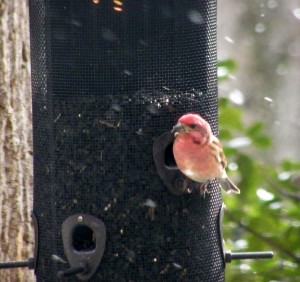Don’t worry PUFIs won’t harm you. They won’t even take you up to the mothership to probe and prod you and send you home with nothing but a vague recollection of bluish lights and otherworldly mutterings. PUFI is simply bird-nerd speak for purple finch.
This “sparrow dipped in raspberry juice,” as described by Roger Tory Peterson, nests primarily in coniferous and mixed woodlands across Canada from British Columbia to Newfoundland and down both coasts to California in the west and New England to Minnesota and West Virginia in the east.
The purple finch is an erratic short distance migrant, generally following the availability of cone crops. Conventional thinking is that the finches that breed farther south like New England and California, etc. remain in the same region year round, while the more northerly nesters are the ones likely to show up at our feeders and feeders across the South to the Mexican border in the winter.
The PUFI is sparrow-sized (5 to 6 inches) and weighs about 1 to 1.5 ounces. The male is the raspberry dipped one. It has a reddish (raspberry) head and breast with red mixed with brown on the back. It also shows red along the sides of the breast with a whitish belly. The male shows a dark ear patch under the red and also a dark malar (throat) streak. Females are brown and white with dark coarse streaking on breast and flanks. They show a whitish eye stripe, dark ear patch and dark malar. Both sexes have deeply notched tails.
There are two subspecies of purple finches – eastern, Carpodacus purpureus purpureus and western, Carpodacus p. californicus. The primary measurable difference between the two is that the western PUFI has a longer tail and shorter wings. In the field, the eastern PUFI male is brighter (rosier) and the eastern female is crisply brown and white with distinct dark streaking on the breast while the western female has a greenish-yellow tinge and more faded-looking breast streaks. There are also slight differences in the vocalizations.
The bird in this area most likely to be confused with the purple finch is the house finch. The house finch, which was originally a western species, was introduced to the east in the 1940s when a few captive birds were released on Long Island. They are now quite common from Canada to Louisiana. And if you see a reddish finch at your feeders in the summer it almost certainly a house finch as they nest in the area.
The red of the male house finch ranges from orange to reddish-orange – it’s not the rosy (raspberry) of the purple finch. The red of the house finch is not as extensive on the back of the head as it is on the purple finch plus the house finch lacks the dark face pattern of the purple finch and it has heavily streaked flanks not present on the male purple finch.
The female house finch has a plain brown or grayish-brown head, lacking the bold face pattern of the female purple finch. And it has blurry streaks on a dingy breast unlike the contrast of the dark streaks on the white breast of the purple finch.
House finches appear to supplant purple finches where the two species are found together. Purple finch populations don’t appear to be in peril but their numbers do appear to be dropping in the East as house finch numbers increase.
There are “murders” of crows and “gaggles” of geese and a group of finches is known as a “charm,” “company” or trembling. My charm of around 20 PUFIs really set my feeders trembling with all their company.

